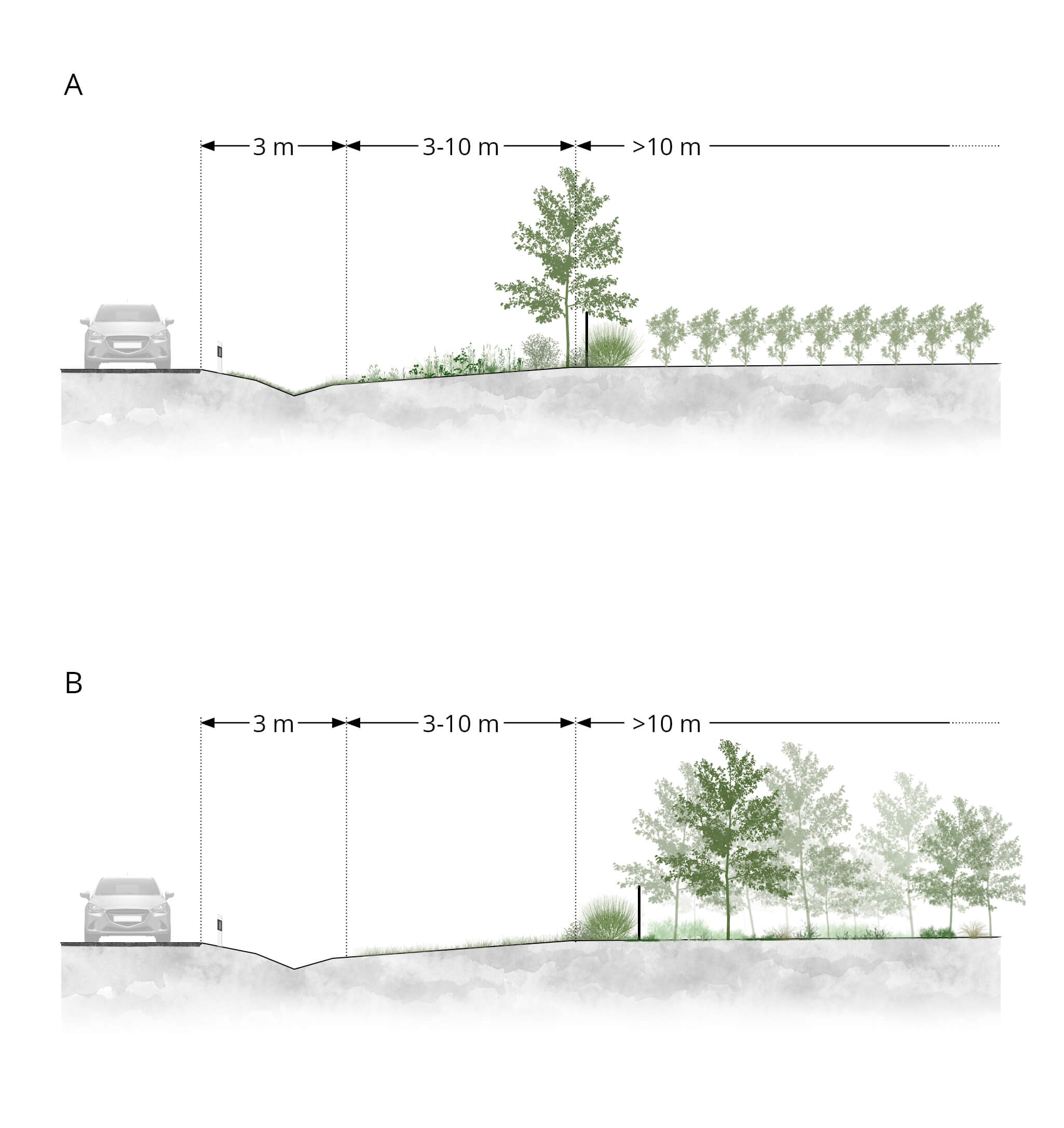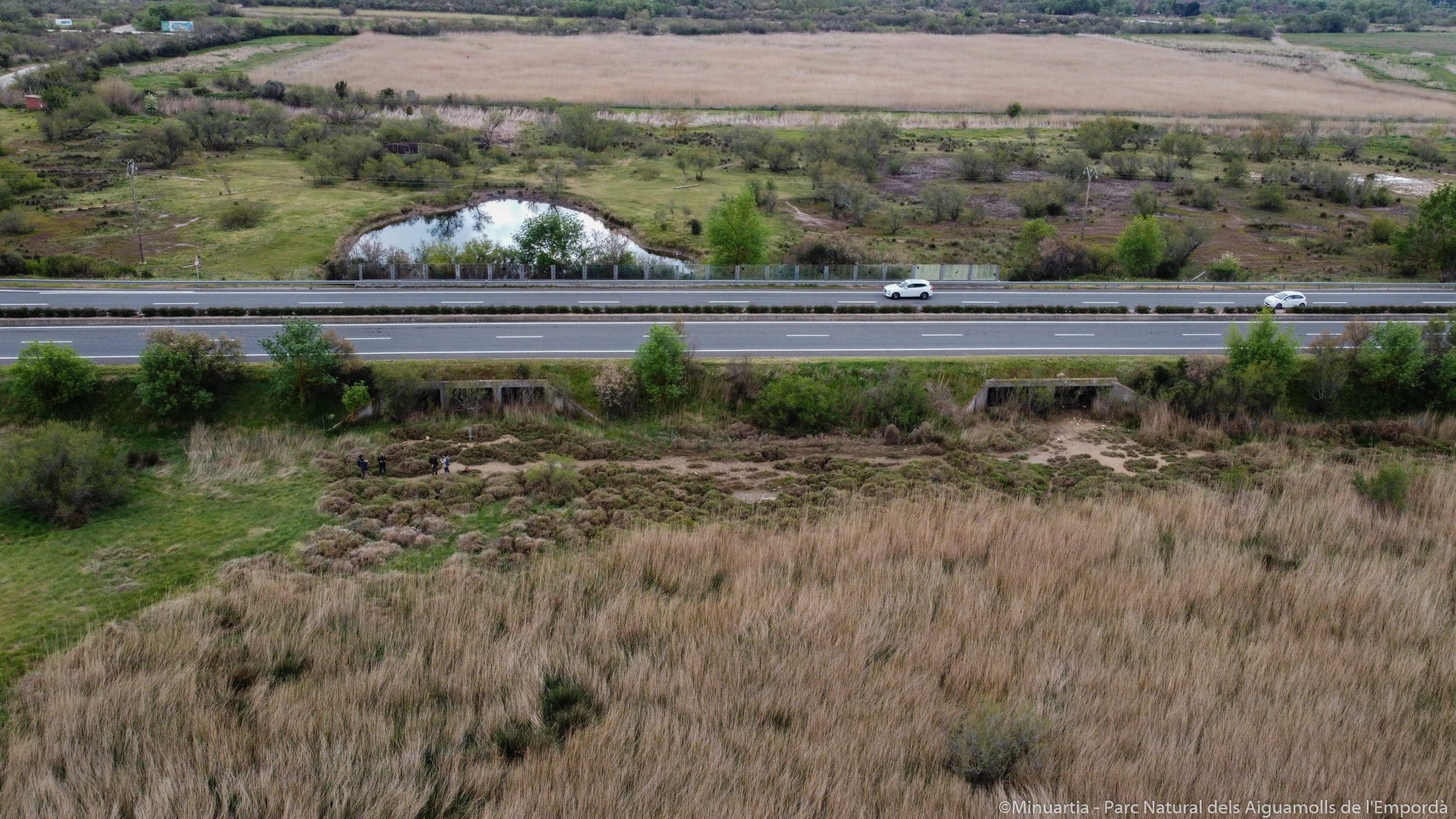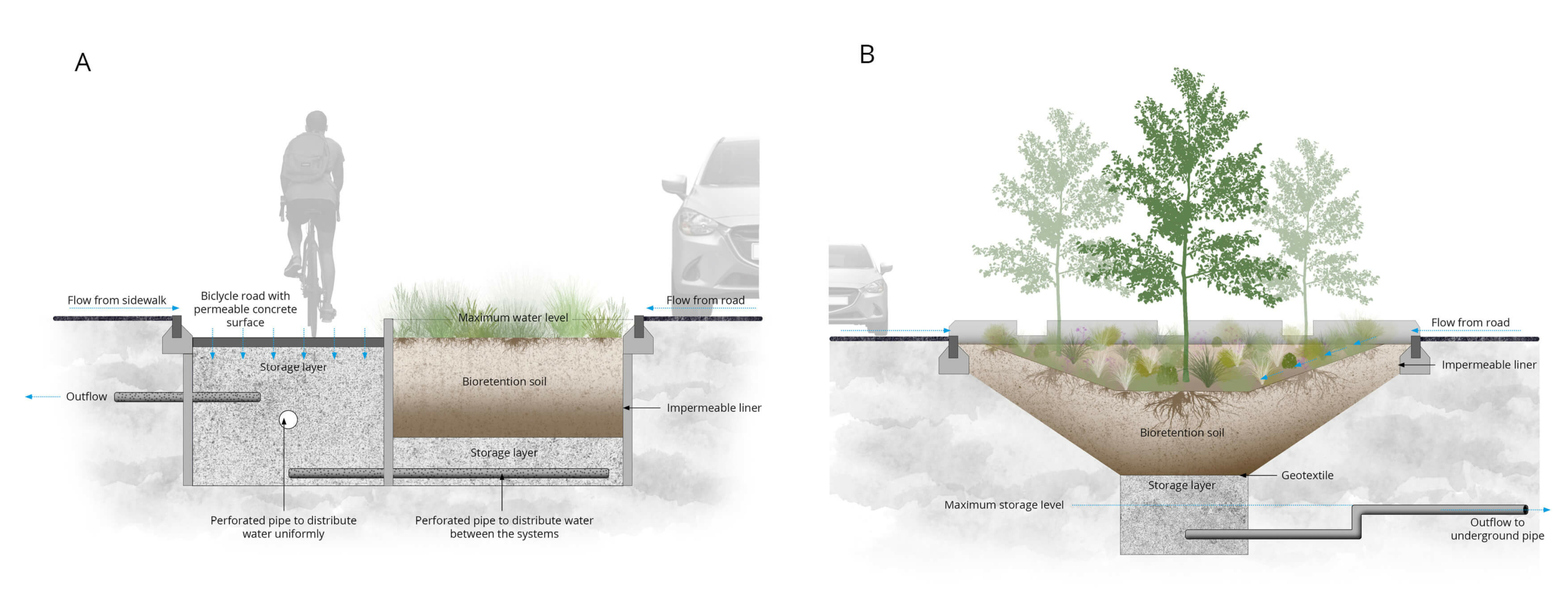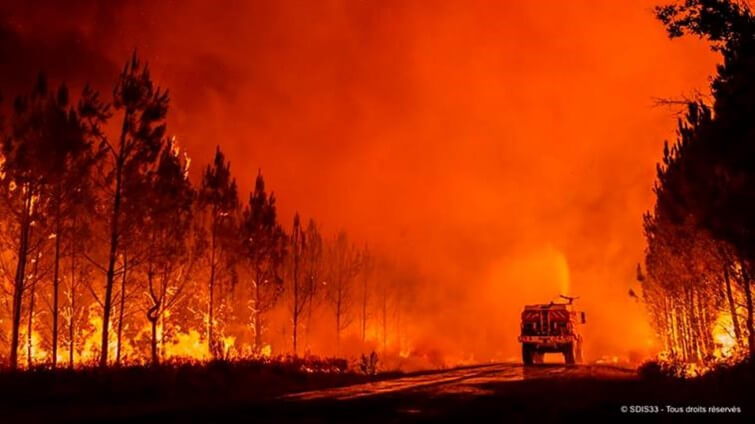Reduction of flooding effects
The number and intensity of floods and flash floods has increased in many parts of Europe and elsewhere during the past decades. This development will continue as climate change progresses. Managers will increasingly have to implement adaptation measures that can reduce damage and costs of flooding to transport infrastructure. Some of these measures can easily be modified to support biodiversity and improve cost-benefit of these measures.
Examples of such measures include:
- Water retention ponds that are linked to drainage systems with capacity to receive large water volumes during flooding events. Such ponds could also provide new habitats for many aquatic and semi-aquatic species if appropriate design and management is ensured. This may include smooth margin slopes to allow amphibian movement or the planting of naturalized aquatic and riparian vegetation (see Section 5.7.2 – Ponds and other blue areas; see Chapter 7 – Maintenance, Sheet 7.4.16 – Management of retention ponds to host wildlife). Furthermore, when located close to the entrances of wildlife crossings they can encourage wildlife to use these passages (Figure 5.9.4).
- To avoid such ponds from inadvertently becoming ecological traps that cause mortality among terrestrial and aquatic fauna, it is crucial to implement several protective measures (see also Section 5.7.2 – Ponds and other blue areas):
- Effective separation between these HTI and traffic should be ensured to avoid AVC.Water chemical and physical conditions should also be monitored to ensure that have appropriate levels for wildlife.
- When waters are polluted, by pesticides or heavy metals fauna access should be prevented.
- Increase the size of transversal drains. The escalating frequency and intensity of floods and flash floods due to climate change will require increasing the hydraulic capacities of existing and new drains. These larger hydraulic structures, like viaducts and enlarged culverts, could bring benefits for biodiversity and ecological connectivity since they could easily be adapted to provide crossing opportunities for wildlife, or if wide enough, even restore and connect habitat on both sides of the infrastructure (see Section 5.5.6 – Adapted viaducts (Landscape underpass); Section 5.5.8 – Multiuse underpasses and Section 5.5.10 – Adapted culverts).
- Increase water infiltration and retention by using green ditches. Naturalizing ditches and verges improve the retention of precipitation water and reduces surface runoff, allowing a slow water infiltration into the soil. Increasing the amount of natural soil and vegetation cover within the Rights of Way (ROW), for example by revegetating embankments, will allow higher infiltration rates and reduce erosion (Figure 5.9.5). This approach will reduce the kerb barrier effect and could increase the corridor effect of linear transport infrastructure. Careful design and maintenance are necessary to avoid attracting wildlife to areas of the infrastructure with a high risk of mortality (see Chapter 1 – Ecological effects of infrastructure).
- Adapt drainage maintenance plans. In some cases, the drainage capacity could be enough to accommodate the flow of a specific watercourse, however flash floods could bring high amounts of debris limiting its functionality. Preventive and continuous maintenance could avoid flooding caused as a result. Accumulated debris could also limit or impede the use of these structures as wildlife passages by blocking the passage or causing a rise in water levels which prevents many species using it (see Chapter 7 – Maintenance, Sheet 7.4.8 – Maintenance of adapted culverts and Sheet 7.4.9 – Maintenance of amphibian passages).
Avoiding the spread of forest fires
Severe droughts and heat waves occur with increasing frequency in Europe, crating conditions that increase the risk for ignition and propagation of wildfires. The effects of climate change combined with rural depopulation and inadequate forest management exacerbate this phenomenon and pose a significant risk to people and wildlife. This is especially true with the so-called ‘sixth generation wildfires’ which are a major concern in many countries as they are often beyond the potential control of firefighting services. These have very high intensity, high speed of propagation, long-distance projection by sparks and unpredictable behaviour due to their capacity to generate strong winds.
Wildfires are a raising hazard causing devastating environmental impacts, loss or injuries to people and serious economic losses. Several studies demonstrated the importance of roads and railways in forest fire ignition, mainly due to discarded cigarettes or by sparks. Management of verge habitats and the proper integration of the infrastructure in the surrounding landscape can significantly contribute to the prevention of forest fires (Figure 5.9.6).
Measures to reduce the spread of forest fires which apply to transport infrastructure are (see also Section 5.7.1 – Verges and other green areas and Chapter 7 – Maintenance, Sheet 7.4.12 – Management of vegetation and Sheet 7.4.15 – Management of verges to reduce forest fire risk in sensitive areas):
- Selecting appropriate plant species to revegetate verges and other green areas within the ROW. Some countries have regulations about species which cannot be planted due to their flammability. This offers an opportunity to promote the planting of rare or endangered species that do not contribute to the spread of fire.
- Spatial configuration and management of vegetation. Strips of land closer to the infrastructure should be tightly mowed, allowing taller vegetation further away (see Section 5.7.1 – Verges and other green areas). Surrounding land uses also influences the risk of wildfire spread and therefore it has to be considered (Figure 5.9.7).
- Preventive management of green areas. Limiting flammable material reduces the possibility of the spread and the intensity of fire.
- Removing dead vegetation like dry wood and leaves and periodical pruning to eliminate dead wood are some of the measures which reduce fuel availability.
- In adjacent habitats, the use of grazing cattle could be a sustainable way of reducing combustible material provided there is an effective physical separation between the grazing habitat and the infrastructure to avoid potential accidents.
- Pruning road verge trees to avoid the continuity of their canopies with trees located in adjacent areas can limit forest fire propagation.
- Monitoring. EWS are especially important in the event of forest fires, since a rapid response can limit the impact. Innovative monitoring and risk evaluation tools are being applied and could be used to green areas linked to transport infrastructure. For example, drones equipped with different types of cameras, such as thermal, infrared or high-definition video, can gather information on vegetation structure, humidity and biomass in order to prevent the risk of fires. These and other sets of data can be collected on drone flights to improve the cost-benefit ratio of this monitoring tool.

Other climate-related hazards
Climate change risks are diverse and so are the effects on transport infrastructure. Some recommendations are given above regarding those most important for TI, however there are others worth mentioning:
- Wind hazards. Powerlines and waterways are probably the modes of transport most affected by this climate hazard. Service disruption to powerlines can be caused directly, through failure of electrical cabling connections, or indirectly, from falling tree damage, both of which increase the risk of fire. On waterways, stronger tides and currents caused by wind can damage canal and port structures while also increasing the energy demand on vessels and placing them at navigational risk.
- The main solution implemented for powerlines is burying, which is the replacement of overhanging wires by underground ones. Besides solving impacts caused by climate change, it eliminates the hazard of bird collision and electrocution (see Section 5.10.2 – Measures to reduce risks caused by powerlines).
- Landslides. Heavy precipitation and thawing permafrost may generate landslides and sink holes. Water management measures to cope with flooding effects could also help to prevent these impacts. Generally, restoring ecosystems on slopes surrounding infrastructure reduces landslide risks. This brings several benefits for biodiversity, such as an increase in habitat availability or enhanced infrastructure corridor effects. On the other hand, attracting wildlife to these habitats near infrastructure could increase AVC.
- Sea-level rise. Projected sea level rise, along with an increase in number and magnitude of storms, will threaten coastal infrastructure. Strategic planning of new infrastructure should incorporate careful evaluation of this risk. When considering this risk for existing infrastructure, a traditional ‘grey’ solution may call for the building of a dyke, however, coastal habitat restoration, such as dunes and wetlands, should be promoted where possible. The environmental and societal benefits are numerous, such as increasing habitat availability, carbon storage, weather regulation and many others.
- Spread of pathogens, pests and Invasive Alien Species. Climate change will alter the distribution of many species and, including harmful species, such as pathogens and pests. These species can affect HTI and dealing with them effectively will require modification of management and maintenance plans. Traditional solutions often rely on pesticides and insecticides that entail negative impacts on biodiversity, but there are alternative solutions which should be prioritised (see Section 5.6.3 – Chemical pollution).
- Frost. The range of temperatures is projected to increase as a result of climate change. Extreme low temperatures increase the risk of icy surfaces, increasing the need for de-icing products. Conventional products degrade the infrastructure, as well as vehicles using them, and the resulting chemicals impact ecosystems and species, especially freshwater ones. Furthermore, these de-icing salts may attract ungulates to roads, increasing the risks of AVC. Alternative and more sustainable products are available, such as acetate or carbohydrate-based de-icers, although their performance is more limited (see Section 5.6.3 – Chemical pollution).


